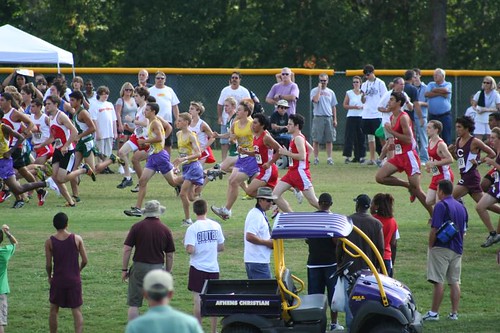So What Exactly is a Harrier Anyway?
5:58 AM Posted by Christopher Byrne
Here is an except from a December 1, 1998 article in Running Times.
On the Scent of History
Tracing Cross Country Running's True Origins
By Roger Robinson
Running Times, December 1998
THE INVENTION OF cross country running as an organized modern sport has always been attributed to Rugby School, mainly because of the paper chase Hare and Hounds in Thomas Hughes' best-selling novel, Tom Brown's Schooldays (1857). That chapter inspired the first adult running club, Thames Hare and Hounds, founded near London in 1868. Its founder, Walter Rye, paid tribute to Rugby School as the cradle of the sport in his seminal essay, "Paper-Chasing and Cross-Country Running" for the Badminton Library in 1887. Pierre de Coubertin, the founder of the modem Olympics, kept the Rugby myth alive. He read Tom Brown's Schooldays at age 12, and formulated his Olympiades during a visit to England's schools in 1883. He praised Rugby's famous principal, Thomas Amold, as the first to develop sports as part of education.
off in the pack, on the hunt for the finish line.
Photograph Copyright 2009 by Eye on Sports Media/ The Cayuga Group, LLC.
All Rights Reserved,
The truth, I was to find, lay 100 miles northwest of Rugby, at Shrewsbury. I went to Shrewsbury one September on official leave from my university. I did not expect to find much. Butler provided such a full narrative of his schooldays in The Way of All Flesh that his biographers have never tried to add to it. He was "listless and unhappy, " the novel tells us, "no greater lover of his school work than of the games. " He wrote that in his 30s, and repeated its unflattering version in autobiographical memoirs penned near the end of his life. There has been no reason to doubt it. It was more for sport than scholarship, therefore, that I asked the librarian at Shrewsbury to find those Hound Books for me. They are crackly old exercise books, such as you'd find in any dusty attic, their pages hand-written in scratchy black ink. The writing changes year by year with each generation of schoolboy secretaries. The oldest is dated 1831, and accounts elsewhere indicate that the sport was established at Shrewsbury by 1819-almost 20 years before Thomas Hughes played Hare and Hounds at Rugby.
The reports of the runs, twice a week from September to the Christmas holidays, are detailed, spirited and sometimes very funny. In imagination I joined those long-dead schoolboys in their zestful enjoyment of hard running over varied country. I also realized, as a scholar, that I held in my hands absolutely authentic documentation of the very early history of modern sport. In these stained and yellow pages, dating back to before the time of Queen Victoria, lie the origins of all the international off-road sports we call cross country, trail running, mountain running and harriers.
A game called "Hunt the Fox" or "Hunt the Hare" had been played in English schools at least since the reign of Queen Elizabeth I. Shakespeare may have played it; he has Hamlet call, "Hide, fox, and all after" when he eludes the Elsinore security guards. At Shrewsbury School, sometime about 1800, the game was organized into an outdoor sport called the Hunt or the Hounds. It was a way for the young gents to practice their future pastime, fox hunting. Two runners called "foxes" ("hares" at Rugby and elsewhere) ran ahead laying a "scent" of shredded paper. After an interval of about five to 10 minutes known as "law", the "pack" was "coupled up" and "threw off' after the scent. There were "checks" (obstacles or false trails), a "view halloa" when the foxes were sighted, and then the "run in, " with the fastest hound getting the honor of "the kill. " Someone was also awarded "the brush. " I prefer not to know what that meant.
SOME OF THIS is still part of our sport. Cross country runners are called harriers, which means "hare-hunters. " The international Hash House Harriers preserve the old game, following a scent of flour now, not paper. A group of runners on a trail, road or track is called a pack. We all still run in the footsteps of the Shrewsbury Hounds. In Shrewsbury, I decided to do that literally;. The hunts each went in an agreed direction, with the foxes providing variety and challenge. Over the years these runs acquired names. So I did my best that week to run these old courses: The Bog, The Drayton, The Tucks and The Long (all 14 miles of it). Often I was turned back by urban sprawl and screaming highways, but I managed to trace some routes and locate landmarks cited in the Hound Books-the Sevem River and little grass-clogged Berwick Brook, Coton Hill and Sundome Farm(still there, squeezed next to a giant retail park), Battlefield (where King Henry IV retained his title in 1403) and the tiny communities of Hencott and Atcham.
So while we all know that Clarke Central High School is known as the Gladiators, I chose to brand this site as the "harriers" because we all know that cross-country runners are a breed apart.
Posted September 1, 2009



0 comments:
Post a Comment